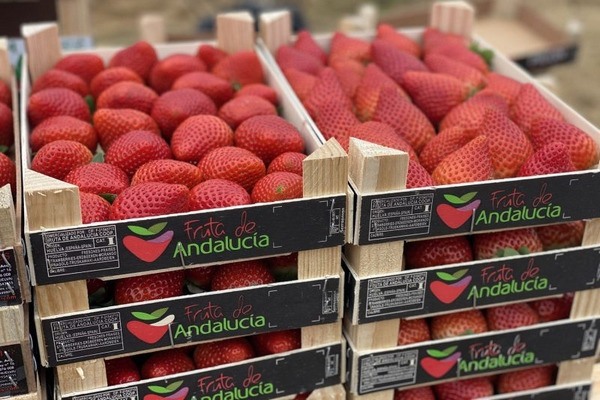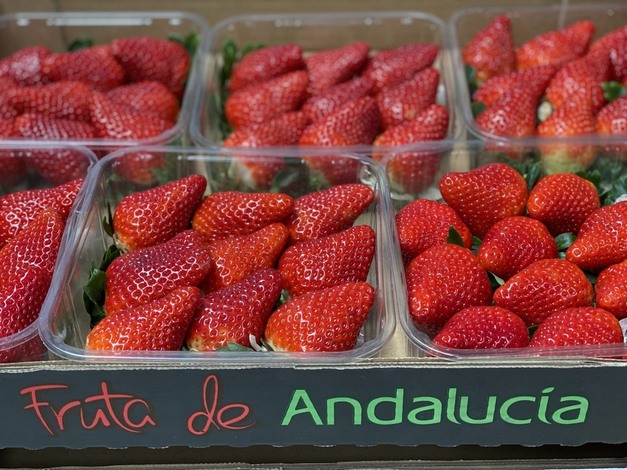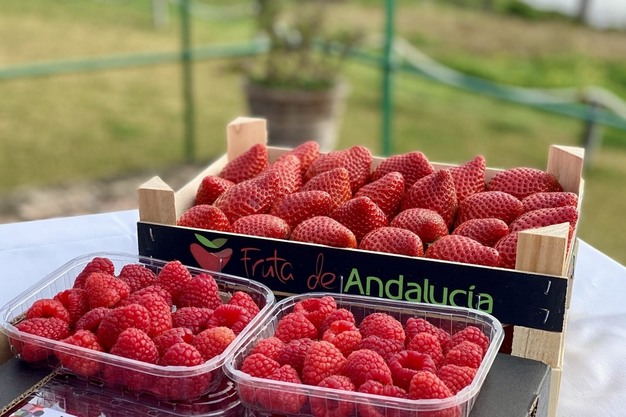In spite of the constant rains in recent weeks in Western Andalusia, the strawberry campaign and the supply are going as expected. "The first strawberries of the season ripened in the first days of December and good temperatures provided excellent conditions for the fruit to acquire the right color, flavor, and size," says Fruta de Andalucía. "January has been a month with a good amount of rain, but temperatures have been low and this has resulted in a lower production. However, this is normal for January. Now in February, the greater number of daylight hours and better temperatures will lead to an increase in production, building up until April, when volumes will peak."
"The best news is the rain and the amount of water in the reservoirs," says the cooperative. "However, since we don't have the water infrastructures that the province of Huelva needs, there have been no significant variations in the water supply authorized by the Administration, with a 25% restriction currently in place," they say.

As far as prices are concerned, "we are seeing the usual trend for weeks when there's a lower strawberry supply." In fact, since the start of the campaign, they have remained above the maximum levels of the last four seasons. "Nonetheless, in order to make a more realistic analysis of prices, you need the figures for the entire season, because we are still practically at the beginning of the campaign."
As far as the demand for strawberries is concerned, "it has so far matched the estimates forecast for the months of December and January. As soon as strawberries become available, the demand follows. We have noticed a small increase in domestic demand, but the European Union and the United Kingdom are still the main destinations," says Fruta de Andalucía.
Specifically, Germany and France are the main markets for Spanish strawberries, accounting for 33.7% and 19.8% of the volume exported to the EU, respectively, according to export data from 2024.

"The European market as a whole is very important for us, but competition from third countries is becoming stronger and stronger. Huelva's berry sector is perfectly aware of this situation, and the only way we can face up to this competition is to guarantee the supply of top-quality strawberries that are far better than those arriving from other countries. We are also looking into diversifying the production and avocados seem a good option."
Fruta de Andalucía is a cooperative made up of 12 companies devoted to the production of berries and citrus fruits. "We have been in business for 10 years and during this time we have been growing in terms of activity, production, and turnover. Thanks to this, Fruta de Andalucía has managed to expand from 1,000 to 1,600 hectares cultivated in the province of Huelva. This has led to a notable increase in production, which has grown from 35,000 tons of fruit in the 2014-2015 season to 45,500 tons in the 2023-2024 campaign. This has also entailed a growth in the number of employees, as today more than 7,100 people are involved in the cultivation, harvesting, packaging and marketing of these fruits."
"This growing activity has also led to a notably positive development of exports thanks to the opening of new markets. From the 30 countries that Fruta de Andalucía was serving at the beginning, the company has now managed to exceed 40 destinations and is now one of the Andalusian companies in the fruit and vegetable sector with the highest volume of exports," they say.

"Moreover, Fruta de Andalucía has also expanded with other crops besides strawberries, blueberries, raspberries, and blackberries. We first introduced citrus fruits and we then added others such as avocados, pitaya, and nuts. We are currently looking into how to diversify our production and avocados seem a good option. We are still in an initial phase and we still need several more seasons to make a real analysis of this crop's growth possibilities, but prospects are very positive."
 For more information:
For more information:
Fruta de Andalucía S.C.A.
C/ Paraguay,16
Moguer, Huelva 21800. Spain
Tel.: +34 959 37 29 45
contacto@frutadeandalucia.com
https://www.frutadeandalucia.com
